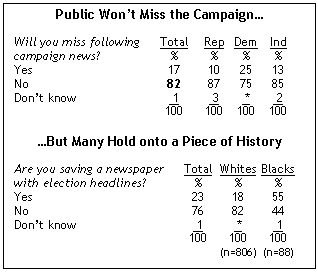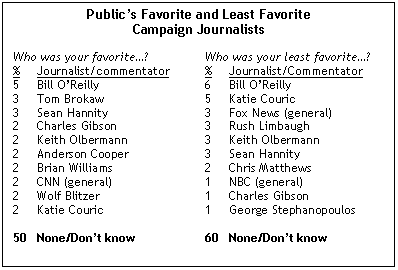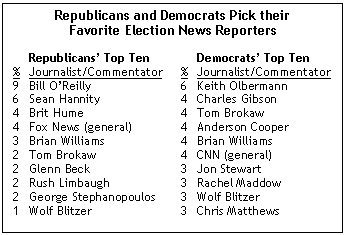Summary of Findings
 By all accounts, the public liked Campaign 2008 and followed election news avidly. But enough is enough. Fully 82% say they will not miss following election news, while only 17% say they will miss it. Even among Democrats, only a quarter say they will miss the campaign.
By all accounts, the public liked Campaign 2008 and followed election news avidly. But enough is enough. Fully 82% say they will not miss following election news, while only 17% say they will miss it. Even among Democrats, only a quarter say they will miss the campaign.
Many Americans (23%) say they are saving a newspaper with headlines about Barack Obama’s victory for posterity. Among African Americans, more than half (55%) say they are saving a newspaper with election headlines. Democrats are much more likely than Republicans to be saving a post-election newspaper (36% vs. 9%).
As expected, the election was the dominant news story last week, with 60% following news about the election very closely and 39% citing it as their top story of the week. Nearly a quarter of Americans (23%) followed news about the congressional elections very closely, with 2% saying they followed it more closely than other any other story.
In other election-related news last week, 39% paid very close attention to plans for the new Obama administration, and 12% listed this as their most closely followed news story. Democrats were much more interested than Republicans in news about the president-elect: 57% of Democrats vs. 24% of Republicans followed plans for the new administration very closely. Among independents, 32% followed the early transition news very closely.
With all the competing election headlines, the public paid relatively little attention to the passage of Proposition 8 in California, which essentially banned same-sex marriage in that state. Only 18% followed this story very closely, and 4% listed this as their most closely followed news story of the week. The national news media devoted 2% of its overall coverage to this story.
America’s Favorite Campaign Journalists
As the Pew Research Center’s Weekly News Interest Index has shown, the public followed news about the 2008 presidential campaign more closely than any presidential election in the past 20 years. Americans relied primarily on television news for information about the campaign, and cable TV was the dominant medium. [See “Internet Now Major Source of Campaign News” released October 31, 2008.]
 When asked to name their favorite and least favorite campaign journalist or commentator, Bill O’Reilly was named most frequently as the favorite – and as the least favorite. O’Reilly was named by 5% as their favorite journalist or commentator, while 3% each named Tom Brokaw and Sean Hannity. However, fully half could not name anyone as their favorite.
When asked to name their favorite and least favorite campaign journalist or commentator, Bill O’Reilly was named most frequently as the favorite – and as the least favorite. O’Reilly was named by 5% as their favorite journalist or commentator, while 3% each named Tom Brokaw and Sean Hannity. However, fully half could not name anyone as their favorite.
When asked to name their least favorite journalist or news commentator who covered the campaign this year, 60% offered no response. Among those who did name someone, O’Reilly also topped the list (at 6%). Katie Couric of CBS News was named by 5% of the public as their least favorite campaign journalist. In addition, 3% named each of the following: the Fox News Channel, Rush Limbaugh, Keith Olbermann, and Sean Hannity.
Partisan Favorites
Republicans and Democrats have different favorites, reflecting the partisan nature of the audiences for the cable news channels. For Republicans, O’Reilly is the top election news journalist or commentator (9% named O’Reilly). Another 6% of Republicans said Hannity is their favorite, and 4% named Fox’s Brit Hume. In addition, 4% of Republicans named the Fox News Channel and 3% named NBC’s Brian Williams.
 At the top of the Democrats’ list is Keith Olbermann of MSNBC (6% of Democrats named Olbermann). Democrats also favor ABC’s Charles Gibson, Tom Brokaw, CNN’s Anderson Cooper and Brian Williams (each was named by 4% of Democrats).
At the top of the Democrats’ list is Keith Olbermann of MSNBC (6% of Democrats named Olbermann). Democrats also favor ABC’s Charles Gibson, Tom Brokaw, CNN’s Anderson Cooper and Brian Williams (each was named by 4% of Democrats).
There also are partisan differences over the list of least favorite campaign journalists. Katie Couric is the most disliked journalist among Republicans – 8% said she was their least favorite journalist. Another 6% of Republicans said Chris Matthews of MSNBC was their least favorite journalist and an equal percentage named Keith Olbermann.
 O’Reilly is the Democrats’ least favorite election journalist – 10% named him. Another 7% of Democrats named O’Reilly’s network, the Fox News Channel, as their least favorite election news source, and 6% named radio talk show host Rush Limbaugh.
O’Reilly is the Democrats’ least favorite election journalist – 10% named him. Another 7% of Democrats named O’Reilly’s network, the Fox News Channel, as their least favorite election news source, and 6% named radio talk show host Rush Limbaugh.
There are few differences among men and women when it comes to their favorite campaign journalist. However, women are more likely than men to say Katie Couric is their least favorite journalist (7% vs. 3%). And more men than women say Keith Olbermann is their least favorite (5% vs. 1%).
These findings are based on the most recent installment of the weekly News Interest Index, an ongoing project of the Pew Research Center for the People & the Press. The index, building on the Center’s longstanding research into public attentiveness to major news stories, examines news interest as it relates to the news media’s agenda. The weekly survey is conducted in conjunction with The Project for Excellence in Journalism’s News Coverage Index, which monitors the news reported by major newspaper, television, radio and online news outlets on an ongoing basis. In the most recent week, data relating to news coverage were collected from November 3-9 and survey data measuring public interest in the top news stories of the week were collected November 7-10 from a nationally representative sample of 1,005 adults.
Public Remains Focused on Economy News
 While the national media focused almost exclusively on election-related news last week, the public continued to keep close track of economic news. Fully 54% followed news about the economy very closely and another 31% followed fairly closely. Roughly three-in-ten (29%) listed the economy as their most closely followed news story. According to Pew’s PEJ, the media devoted 7% of its overall coverage to the economic crisis.
While the national media focused almost exclusively on election-related news last week, the public continued to keep close track of economic news. Fully 54% followed news about the economy very closely and another 31% followed fairly closely. Roughly three-in-ten (29%) listed the economy as their most closely followed news story. According to Pew’s PEJ, the media devoted 7% of its overall coverage to the economic crisis.
Americans also paid close attention to the nation’s rising unemployment rate. Fully 39% followed the latest unemployment reports very closely and another 32% paid fairly close attention to this story. Interest in unemployment news was significantly higher than in June of this year, amid reports of widespread job losses.
Democrats followed last week’s news about rising unemployment much more closely than did Republicans (52% vs. 26% followed very closely). And those with annual household incomes under $50,000 followed the story more closely than did those making $50,000 a year or more (44% vs. 35% very closely).
About the News Interest Index
The News Interest Index is a weekly survey conducted by the Pew Research Center for the People & the Press aimed at gauging the public’s interest in and reaction to major news events.
This project has been undertaken in conjunction with the Project for Excellence in Journalism’s News Coverage Index, an ongoing content analysis of the news. The News Coverage Index catalogues the news from top news organizations across five major sectors of the media: newspapers, network television, cable television, radio and the internet. Each week (from Sunday through Friday) PEJ will compile this data to identify the top stories for the week. The News Interest Index survey will collect data from Friday through Monday to gauge public interest in the most covered stories of the week.
Results for the weekly surveys are based on telephone interviews among a nationwide sample of approximately 1,000 adults, 18 years of age or older, conducted under the direction of ORC (Opinion Research Corporation). For results based on the total sample, one can say with 95% confidence that the error attributable to sampling is plus or minus 3.5 percentage points.
In addition to sampling error, one should bear in mind that question wording and practical difficulties in conducting surveys can introduce error or bias into the findings of opinion polls, and that results based on subgroups will have larger margins of error.
For more information about the Project for Excellence in Journalism’s News Coverage Index, go to www.pewresearch.org/journalism.


